Jan. 19 - Jan. 23, 2009


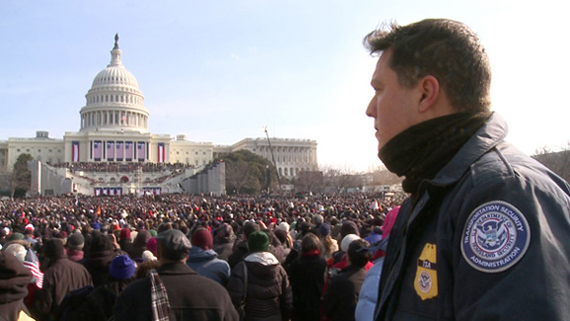
TSA had a high-profile role at the Inauguration of President Obama as TSOs and other employees from around the country helped provide security. Read more Photo by Jeremy Trujillo.
The TSA Experience
- Check out the new story from California.
CFC
- Check out the new stories from Florida and California.
More News
- TSA Survey Shows Increased Employee Satisfaction
- Team Iowa Develops Daily Video for Briefing Staff
- SSI Hero and Sentinel Awards Presented
- Spokane Battled Northwest Blizzard's Coastal Fallout
- Alert Officer Assists Injured Passenger
- Lawson Named 'Cutting Edge' Speaker
News
TSA Helps Secure Inauguration
By Christine Mooney, Office of Strategic Communications/Public Affairs
As some 1.8 million people converged on Washington’s National Mall Tuesday, TSA was an integral part of the largest inaugural security operation in history, protecting President Barack Obama as he took the Oath of Office.TSA joined 57 other federal, state and local agencies that worked together to protect the President and those attending the ceremony. While our officers are best known for their work in U.S. airports, TSA was called upon to lend its expertise to help screen roughly 240,000 ticketed spectators at the swearing -in ceremony, plus hundreds of thousands more at checkpoints that stretched west down the Mall from the Capitol.
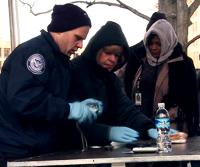 About 300 transportation security officers (TSOs) were among the many TSA security personnel who supported the U.S. Secret Service, the lead federal agency responsible for the overall Inauguration security plan. “We greatly appreciate the partnership and support TSA provided throughout the campaign and at the Inauguration,” said Secret Service Director Mark Sullivan. “Their officers’ screening expertise played a vital role in securing the President and the American public during these historic events.”
About 300 transportation security officers (TSOs) were among the many TSA security personnel who supported the U.S. Secret Service, the lead federal agency responsible for the overall Inauguration security plan. “We greatly appreciate the partnership and support TSA provided throughout the campaign and at the Inauguration,” said Secret Service Director Mark Sullivan. “Their officers’ screening expertise played a vital role in securing the President and the American public during these historic events.”
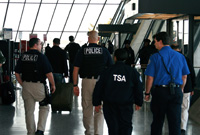 In addition to officers helping to screen participants on the Mall, TSA’s Visible Intermodal Prevention and Response (VIPR) teams also worked seamlessly with local law enforcement to provide deterrent presence and detection capabilities, and an unpredictable layer of security at Washington’s Union Station, mass transit Metro stops and other locations. The VIPR teams – made up of federal air marshals, surface transportation security inspectors, behavior detection officers and explosives detection canine teams, as well as TSOs – helped create a calm atmosphere and sense of overall protection by their overt presence and coordination.
In addition to officers helping to screen participants on the Mall, TSA’s Visible Intermodal Prevention and Response (VIPR) teams also worked seamlessly with local law enforcement to provide deterrent presence and detection capabilities, and an unpredictable layer of security at Washington’s Union Station, mass transit Metro stops and other locations. The VIPR teams – made up of federal air marshals, surface transportation security inspectors, behavior detection officers and explosives detection canine teams, as well as TSOs – helped create a calm atmosphere and sense of overall protection by their overt presence and coordination.
“I’m very impressed at what I’ve seen at Union Station,” said George Papantoniou, deputy assistant director of the Federal Air Marshal Service. “It’s very positive to see everyone working so well to assure the safety and security of the crowd.”
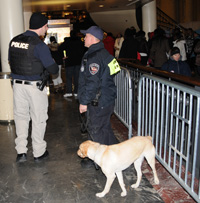 From the U.S. Capitol to the Lincoln Memorial, TSOs found honor and excitement in their mission of securing President Obama and the American public at the Inauguration. “I’m very excited to participate in the security of this once-in-a-lifetime event,” said TSO Randy Holmes, who traveled from his home base at Cincinnati/Northern Kentucky International Airport.
From the U.S. Capitol to the Lincoln Memorial, TSOs found honor and excitement in their mission of securing President Obama and the American public at the Inauguration. “I’m very excited to participate in the security of this once-in-a-lifetime event,” said TSO Randy Holmes, who traveled from his home base at Cincinnati/Northern Kentucky International Airport.
TSO Patricia Nunez of Corpus Christi (Texas) International Airport echoed that sentiment. “I’m very happy to be here for the people and our President,” she said. “That is why I wanted to volunteer my help.”
TSA also deployed more than three dozen canine teams at the request of Secret Service to provide a mobile, explosive-detection capability to augment their efforts. These teams searched cars, packages and other items.
 Inauguration spectators reciprocated with “thank you for being there” as they exited the Mall for the inaugural parade. “It was truly an honor to hear the spectators thank us,” said TSO Edward Woodall of Seattle-Tacoma International Airport. “It was remarkable to see spectators and security working so well with one another.”
Inauguration spectators reciprocated with “thank you for being there” as they exited the Mall for the inaugural parade. “It was truly an honor to hear the spectators thank us,” said TSO Edward Woodall of Seattle-Tacoma International Airport. “It was remarkable to see spectators and security working so well with one another.”
Screening on the Mall during the inaugural ceremony was the culmination of years of partnership with the Secret Service. During the last presidential campaign, TSA officers supported their efforts at dozens of campaign stops and at both national conventions.
At D.C. area-airports, air travelers passing through security checkpoints on their way home from the Inauguration may well have seen some of the same officers who had been on the Mall, still working tirelessly to keep the public safe.
Photos by Brigitte Dittberner, Jeremy Trujillo, and Nelson Minerly

The Support Center Evolves With a Name Change
By Michael Hendrix and Jason Landon, Evolution team members
The Deployment Support Center is now the Evolution Support Center (ESC), a name change that better captures its mission of continually supporting all Evolution-related activities – not just training deployment.
In late September, the center opened phone lines, started answering e-mails and launched a 24-hour Evolution support operation at TSA headquarters. The mission was simple: Do whatever it takes to provide the best possible support for Evolution facilitators in the field by resolving issues efficiently and effectively. But the telephone calls and e-mails generated ideas and energy that meant a more interactive role would be necessary for the center to succeed in supporting Evolution efforts in the field.
“The commitment of these individuals ensures that the field’s perspective is incorporated into Evolution programs throughout the agency,” said Susan Tashiro, general manager, Innovation. “As Evolution policies and initiatives are established, the ESC provides a vital link between practical field experience and policy solutions to ensure the sustainability of Evolution’s culture change.”
ESC members are from the field and all have been trained as ENGAGE! facilitators so they are uniquely situated to understand the topics raised by the field. Because of their direct, constant contact with the field, they are providing field-operations insight to program offices throughout headquarters. Evolution is in motion.
Evolution: In the FSD's Own Words
I found ENGAGE! and COACH! training to be closely linked to the key tenets of the Model Workplace Program and all we have been doing to build the Integrated Conflict Management System for our workforce. Empowerment means implicit trust in the experience and judgment of our security officers – a fundamental that is essential to any high- performance organization within TSA. – FSD Louis A. Traverzo, General Mitchell International Airport (Milwaukee)
Engage the Evolution team with your questions and suggestions at ENGAGEevolution@dhs.gov.
More News
TSA Survey Shows Increased Employee Satisfaction
By Amber Beckes, program analyst, Office of Human Capital

Employees participating in the latest Organizational Satisfaction Survey (OSS) said TSA is making progress, with some of the strongest ratings shown in Diversity (66 percent favorable), Teamwork (57 percent) and Customer Orientation (54 percent).
Satisfaction increased in 12 of 17 categories. Showing the greatest improvement were Job Security/Commitment to Workforce, up 15 points from 21 to 36 percent favorable; Organizational Communication up 12 points from 35 to 47; and Work Environment/Quality of Work Life, up 10 from 37 to 47. An 18th categories – Performance – was added to this year's survey.
The OSS results were released Jan. 7 and posted on the TSA Intranet. Over the next few weeks, FSDs and other leaders will decide how best to communicate results to their respective workforces and how to engage employees in action planning for improvement. Leadership feedback loops have been built into the survey process to see how successful communications, action planning, and employee engagement are at each location.
Probably the most significant and telling results are that job satisfaction is at 64 percent favorable (up 5 percentage points from 2006), and 78 percent of employees say they intend to stay with TSA (up 9 points).
Employee satisfaction declined in three areas: Leadership and Quality (down 4 percentage points), Fairness and Treatment of Others (down 4), and Customer Orientation (down 1). Innovation and Rewards/Recognition continue to remain the lowest rated categories but are showing improvement.
“We are committed to making TSA a collaborative and engaged workplace, and I encourage you to get involved,” Acting Administrator Gale Rossides recently wrote to the workforce. “TSA is committed to the success of our engagement programs including the Idea Factory, the National Advisory Council and local advisory councils.TSA will continue to emphasize the fundamentals of the Integrated Conflict Management System (ICMS) to ensure that workplace conflict is effectively managed in a fair and responsible way. We will also develop new initiatives to target specific areas in need of improvement. With your involvement, the Senior Leadership Team hopes these and other initiatives will have a positive impact on job satisfaction at TSA.”
The Corporate Snapshots and the Frequently Asked Questions (FAQs) on results are available on iShare. Questions on results can be sent to TSAWorkforceSurveys@dhs.gov.
Team Iowa Develops Daily Video for Briefing Staff
by Carrie Harmon, Office of Strategic Communications/Public Affairs

TSA at Des Moines International Airport (DSM) is piloting another innovative tool to improve internal communications: the Video Five Area Briefing, or V- FAB, a daily computerized briefing for staff throughout Iowa.
“The V-FAB provides officers with a quality in-briefing at the start of every important day,” said DSM Federal Security Director Jay Brainard. “A good shift briefing is important as it is the only time of the day where we have the opportunity to personally reach out and touch every one of our officers. Through the V-FAB, we hope to greatly enhance the security and communication culture within our workforce.”
Daily reports for the five-part briefing are compiled by staff in the DSM coordination center. V-FABs start each briefing with the Pandora Report, which highlights security events from other airports that can benefit operations around the country. An Intelligence section incorporates not only items used in daily briefings by TSA at all airports, but items such as a leadership message, perhaps on a threat or trend, that is intended to motivate the team. The site also provides a convenient way for Team Iowa departments and functions, such as training, bomb appraisal officers, and surface transportation inspectors, to share information quickly and efficiently with their colleagues.
The briefing is compiled by Coordination Center Officers Tim Kinnan, Lindsey Pantzlaff, and Virginia Foersch. Pantzlaff said working on V-FAB helps fulfill her goal of being “a major contributor to this agency and a threat to our enemies.”
TSA at other airports can access V-FAB through iShare.
“FSD Brainard and his staff do a great job keeping our TSOs informed, and the V-FAB is another innovative way of keeping operationally significant information flowing to each and every employee throughout the entire state of Iowa,“ said TSA North Central Area Director Mark Haught. “This new tool is another example of TSA’s evolution.”
SSI Hero and Sentinel Awards Presented
By Jennifer Hill-Wilson, program analyst, Sensitive Security Information Office

Paul Murphy (left) receives an SSI Hero
award from FSD Robert Krekorian
of Manchester-Boston airport. Photo
courtesy of TSA Manchester-Boston
While conducting a comprehensive inspection, Paul Murphy, a transportation security inspector at Manchester- Boston Regional Airport, noticed that employees for an airline were not documenting or handling SSI properly. As a result, the airline changed its practices to meet SSI requirements.
For his efforts, Murphy was one of four TSA employees recognized by the SSI Office with a Hero award. The award is given to individuals who demonstrate a willingness to go above and beyond the call of duty to ensure SSI is safely shared, and handled appropriately. Others recognized with a Hero award as part of SSI Awareness Week were TSO Joe Orr, Detroit Metropolitan Wayne County Airport; Dorothy Washington, master security training instructor and records manager, Chicago O’Hare International Airport; and Linda Witt, program analyst and SSI coordinator, George Bush Intercontinental Airport, Houston.
AFSD Rick Fraelick of Manchester-Boston said of Murphy, “His work ethic and attention to detail have always been a source of pride for all of us.”
SSI Director Andrew Colsky said, “It was inspiring to read the great work described in the 30 nominations we received.” From those nominations, six employees who demonstrated strong understanding of SSI policy and procedure through their job performance received Sentinel awards. They are:
Gerald Benson, security manager, and Tim Halligan, program analyst and SSI coordinator, Indianapolis International Airport; Tom Finneman, senior international inspector, Miami International Office; Sandra Heredia, transportation security inspector and SSI coordinator, Santa Barbara (Calif.) Municipal Airport; Benny Zayas, transportation security officer, Luis Munoz Marin International Airport, San Juan, Puerto Rico; and Lisa Walby, transportation security analyst, Office of Intelligence.
Spokane Battled Northwest Blizzard's Coastal Fallout
From TSA Spokane (Wash.) International Airport

Photo of courtesy of TSA Spokane
While attention was focused on the shutdown of airports in Portland, Ore., and Seattle because of blizzards, much of the fallout of those holiday storms settled on TSA employees at Spokane International Airport.
That city also was crippled by road closures, school cancellations and power outages. TSA Spokane, the Spokane airport authority and airline operators coped, too, with more than 75 flight cancellations and 110 delays.
But the severe weather also caused scores of diversions from Portland and Seattle into Spokane, adding overflow to the ranks of passengers forced into overnight stays at the airport.
TSA employees kept the checkpoints running and secure while the airport authority coordinated cots and blankets for passengers. Carrier employees worked long hours to get passengers re-booked.
With more than six feet of snow on the ground, some employees stayed at the airport for up to three days, shared rides in four-wheel-drive vehicles, and helped dig out each others cars.
“Spirits remained high for TSA Spokane, as well as for airport and carrier employees,” said Chris Cox, TSA’s stakeholder liaison at the airport. “All remained mission focused. A well-coached team stepped up to the challenge and overcame all odds with teamwork and comradery!”
Alert Officer Assists Injured Passenger
By Patricia Westbrook, supervisory TSO, Southwest Florida International Airport, Fort Myers
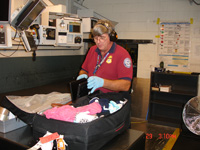
TSO Bill Wheeler screens luggage.
Photo by Patricia Westbrook
TSO Bill Wheeler, a baggage screener at Southwest Florida International for about a year, had not yet had ENGAGE! training, but on Dec. 22 he instinctively used the tools of that training – See, Think, Feel and Do.
Wheeler noticed a woman sitting at a café who did not look well. When he asked if she needed help, she removed a cloth covering her face to reveal bruising and a large bump on her forehead. As a precaution, Wheeler convinced her to call paramedics.
She explained that she fell while walking from the parking lot to the terminal. She and her husband were at the airport to pick up their grandchildren, visiting for the holidays.
“The same qualities that make Bill a good samaritan also make him a very effective deterrent to those with harmful intent,” said Gloria Campbell, customer support and quality improvement manager.
Lawson Named 'Cutting Edge' Speaker
By Nicole Raymond, Office of Information Technology
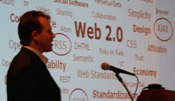
Kevin Lawson presenting
at symposium. Photo courtesy
of GTRA
Kevin Lawson, branch chief of Applications Development in the Office of Information Technology, was named Most Cutting Edge Speaker at the Government Technology Research Alliance (GTRA) Symposium, it was announced Jan. 8. Lawson’s presentation at the December symposium focused on implementation of Web 2.0 technologies at TSA, including IdeaFactory, the Evolution of Security Blog, and iShare. As an award winner, Lawson was invited to join the GTRA Advisory Board and, with other executive-level government leaders, to collaborate and strategize on critical and emerging federal IT initiatives.
CFC
TSA Southwest Florida Surpasses CFC Goal
TSA employees at Southwest Florida International Airport, Fort Myers, contributed $18,547 to the Combined Federal Campaign, exceeding 2008 contributions by 22 percent, with a 20 percent participation level. “With the food banks barely keeping food in stock and the homeless shelters overpopulated, we all worked especially hard to beat last year’s total,” said Becky Kelley, financial specialist and CFC coordinator. She said they successfully got the word out for CFC at shift briefings.
Ontario Officers Generous in CFC Drive
Nico Melendez, Office of Strategic Communications/Public Affairs
The Combined Federal Campaign at Ontario (Calif.) International Airport raised more than $38,000. “I really appreciated this year’s effort to build our CFC campaign at Ontario,” said FSD Shannon Garcia-Hamilton. “The increase in donations by almost 20 percent, even in tough economic times, demonstrates the generosity of spirit that our officers have for other people who may be in need.” Fundraising events included a silent auction that raised $416 and a bake sale that brought in about $200, said TSO April Ellis, a key CFC worker.
The TSA Experience
Ontario TSO Helps Make Rose Parade a Success
By Nico Melendez, Office of Strategic Communications/Public Affairs

STSO Brian Home was on the float
team that built “Bollywood Dreams,”
capturing a wedding scene in a
tribute to India’s film industry.
Photo courtesy of Connie Brown
As he has since the early 1980s, STSO Brian Home of Ontario (Calif.) International Airport has volunteered his time to make the “granddaddy of all parades” a smashing success. This year, Horne took 40 hours of leave to work on the City of Sierra Madre’s float, one of only six self-built floats still in Pasadena’s Rose Parade.
“Working on a Rose Parade float is something we get to do every year, and let the people of the world enjoy our beautiful creation,” said Home, Air Force veteran who has worked for TSA since 2002.
The Southern California native helped build the float’s structure. “The structure is the key to the whole float,” he said. “Everyone enjoys the flowers, but if we didn’t have a firm structure, there is no way that float would get down the street.”
The biggest challenge “is taking someone’s two-dimensional design and turning it into a three- dimension object that rolls down Colorado Boulevard,” said Home, who finds great reward in working with dozens of people to pull off an event seen worldwide.
His team’s float – which cost about $65,000, all raised through fundraisers and donations – won the Lathrop K. Leishman Award for the most beautiful, non-commercial float in the parade.
E-mail your comments and suggestions.





